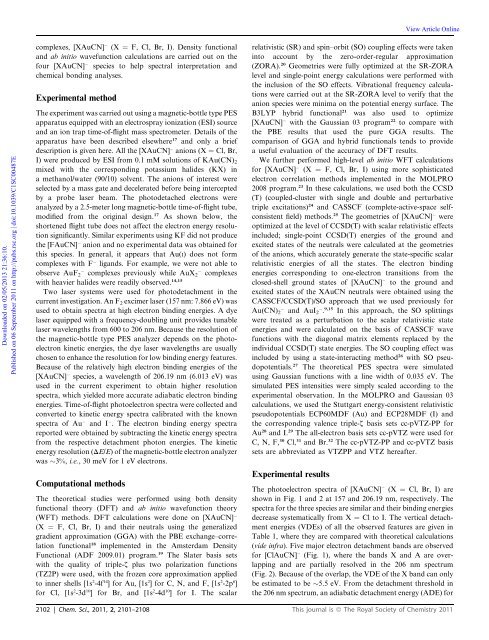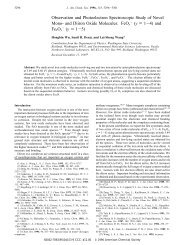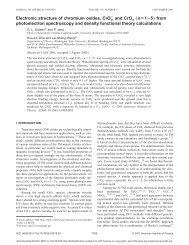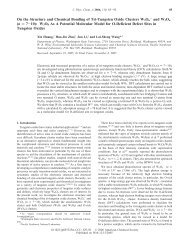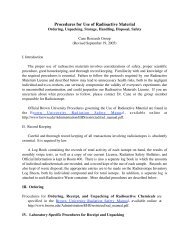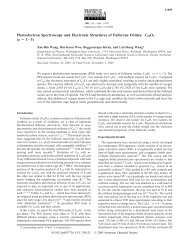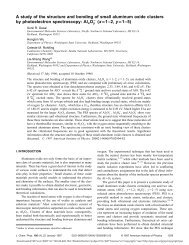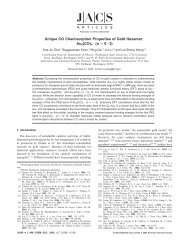Chemical Science EDGE ARTICLE - Chemistry Department at ...
Chemical Science EDGE ARTICLE - Chemistry Department at ...
Chemical Science EDGE ARTICLE - Chemistry Department at ...
Create successful ePaper yourself
Turn your PDF publications into a flip-book with our unique Google optimized e-Paper software.
Downloaded on 02/05/2013 21:36:10.Published on 06 September 2011 on http://pubs.rsc.org | doi:10.1039/C1SC00487Ecomplexes, [XAuCN] (X ¼ F, Cl, Br, I). Density functionaland ab initio wavefunction calcul<strong>at</strong>ions are carried out on thefour [XAuCN] species to help spectral interpret<strong>at</strong>ion andchemical bonding analyses.Experimental methodThe experiment was carried out using a magnetic-bottle type PESappar<strong>at</strong>us equipped with an electrospray ioniz<strong>at</strong>ion (ESI) sourceand an ion trap time-of-flight mass spectrometer. Details of theappar<strong>at</strong>us have been described elsewhere 17 and only a briefdescription is given here. All the [XAuCN] anions (X ¼ Cl, Br,I) were produced by ESI from 0.1 mM solutions of KAu(CN) 2mixed with the corresponding potassium halides (KX) ina methanol/w<strong>at</strong>er (90/10) solvent. The anions of interest wereselected by a mass g<strong>at</strong>e and deceler<strong>at</strong>ed before being interceptedby a probe laser beam. The photodetached electrons wereanalyzed by a 2.5-meter long magnetic-bottle time-of-flight tube,modified from the original design. 17 As shown below, theshortened flight tube does not affect the electron energy resolutionsignificantly. Similar experiments using KF did not producethe [FAuCN] anion and no experimental d<strong>at</strong>a was obtained forthis species. In general, it appears th<strong>at</strong> Au(I) does not formcomplexes with F ligands. For example, we were not able toobserve AuF 2 complexes previously while AuX 2 complexeswith heavier halides were readily observed. 14,15Two laser systems were used for photodetachment in thecurrent investig<strong>at</strong>ion. An F 2 excimer laser (157 nm: 7.866 eV) wasused to obtain spectra <strong>at</strong> high electron binding energies. A dyelaser equipped with a frequency-doubling unit provides tunablelaser wavelengths from 600 to 206 nm. Because the resolution ofthe magnetic-bottle type PES analyzer depends on the photoelectronkinetic energies, the dye laser wavelengths are usuallychosen to enhance the resolution for low binding energy fe<strong>at</strong>ures.Because of the rel<strong>at</strong>ively high electron binding energies of the[XAuCN] species, a wavelength of 206.19 nm (6.013 eV) wasused in the current experiment to obtain higher resolutionspectra, which yielded more accur<strong>at</strong>e adiab<strong>at</strong>ic electron bindingenergies. Time-of-flight photoelectron spectra were collected andconverted to kinetic energy spectra calibr<strong>at</strong>ed with the knownspectra of Au and I . The electron binding energy spectrareported were obtained by subtracting the kinetic energy spectrafrom the respective detachment photon energies. The kineticenergy resolution (DE/E) of the magnetic-bottle electron analyzerwas 3%, i.e., 30 meV for 1 eV electrons.Comput<strong>at</strong>ional methodsThe theoretical studies were performed using both densityfunctional theory (DFT) and ab initio wavefunction theory(WFT) methods. DFT calcul<strong>at</strong>ions were done on [XAuCN](X ¼ F, Cl, Br, I) and their neutrals using the generalizedgradient approxim<strong>at</strong>ion (GGA) with the PBE exchange–correl<strong>at</strong>ionfunctional 18 implemented in the Amsterdam DensityFunctional (ADF 2009.01) program. 19 The Sl<strong>at</strong>er basis setswith the quality of triple-z plus two polariz<strong>at</strong>ion functions(TZ2P) were used, with the frozen core approxim<strong>at</strong>ion appliedto inner shells [1s 2 -4f 14 ] for Au, [1s 2 ] for C, N, and F, [1s 2 -2p 6 ]for Cl, [1s 2 -3d 10 ] for Br, and [1s 2 -4d 10 ] for I. The scalarrel<strong>at</strong>ivistic (SR) and spin–orbit (SO) coupling effects were takeninto account by the zero-order-regular approxim<strong>at</strong>ion(ZORA). 20 Geometries were fully optimized <strong>at</strong> the SR-ZORAlevel and single-point energy calcul<strong>at</strong>ions were performed withthe inclusion of the SO effects. Vibr<strong>at</strong>ional frequency calcul<strong>at</strong>ionswere carried out <strong>at</strong> the SR-ZORA level to verify th<strong>at</strong> theanion species were minima on the potential energy surface. TheB3LYP hybrid functional 21 was also used to optimize[XAuCN] with the Gaussian 03 program 22 to compare withthe PBE results th<strong>at</strong> used the pure GGA results. Thecomparison of GGA and hybrid functionals tends to providea useful evalu<strong>at</strong>ion of the accuracy of DFT results.We further performed high-level ab initio WFT calcul<strong>at</strong>ionsfor [XAuCN] (X ¼ F, Cl, Br, I) using more sophistic<strong>at</strong>edelectron correl<strong>at</strong>ion methods implemented in the MOLPRO2008 program. 23 In these calcul<strong>at</strong>ions, we used both the CCSD(T) (coupled-cluster with single and double and perturb<strong>at</strong>ivetriple excit<strong>at</strong>ions) 24 and CASSCF (complete-active-space selfconsistentfield) methods. 25 The geometries of [XAuCN] wereoptimized <strong>at</strong> the level of CCSD(T) with scalar rel<strong>at</strong>ivistic effectsincluded; single-point CCSD(T) energies of the ground andexcited st<strong>at</strong>es of the neutrals were calcul<strong>at</strong>ed <strong>at</strong> the geometriesof the anions, which accur<strong>at</strong>ely gener<strong>at</strong>e the st<strong>at</strong>e-specific scalarrel<strong>at</strong>ivistic energies of all the st<strong>at</strong>es. The electron bindingenergies corresponding to one-electron transitions from theclosed-shell ground st<strong>at</strong>es of [XAuCN] to the ground andexcited st<strong>at</strong>es of the XAuCN neutrals were obtained using theCASSCF/CCSD(T)/SO approach th<strong>at</strong> we used previously forAu(CN) 2 and AuI 2 . 9,15 In this approach, the SO splittingswere tre<strong>at</strong>ed as a perturb<strong>at</strong>ion to the scalar rel<strong>at</strong>ivistic st<strong>at</strong>eenergies and were calcul<strong>at</strong>ed on the basis of CASSCF wavefunctions with the diagonal m<strong>at</strong>rix elements replaced by theindividual CCSD(T) st<strong>at</strong>e energies. The SO coupling effect wasincluded by using a st<strong>at</strong>e-interacting method 26 with SO pseudopotentials.27 The theoretical PES spectra were simul<strong>at</strong>edusing Gaussian functions with a line width of 0.035 eV. Thesimul<strong>at</strong>ed PES intensities were simply scaled according to theexperimental observ<strong>at</strong>ion. In the MOLPRO and Gaussian 03calcul<strong>at</strong>ions, we used the Stuttgart energy-consistent rel<strong>at</strong>ivisticpseudopotentials ECP60MDF (Au) and ECP28MDF (I) andthe corresponding valence triple-z basis sets cc-pVTZ-PP forAu 28 and I. 29 The all-electron basis sets cc-pVTZ were used forC, N, F, 30 Cl, 31 and Br. 32 The cc-pVTZ-PP and cc-pVTZ basissets are abbrevi<strong>at</strong>ed as VTZPP and VTZ hereafter.Experimental resultsView Article OnlineThe photoelectron spectra of [XAuCN] (X ¼ Cl, Br, I) areshown in Fig. 1 and 2 <strong>at</strong> 157 and 206.19 nm, respectively. Thespectra for the three species are similar and their binding energiesdecrease system<strong>at</strong>ically from X ¼ Cl to I. The vertical detachmentenergies (VDEs) of all the observed fe<strong>at</strong>ures are given inTable 1, where they are compared with theoretical calcul<strong>at</strong>ions(vide infra). Five major electron detachment bands are observedfor [ClAuCN] (Fig. 1), where the bands X and A are overlappingand are partially resolved in the 206 nm spectrum(Fig. 2). Because of the overlap, the VDE of the X band can onlybe estim<strong>at</strong>ed to be 5.5 eV. From the detachment threshold inthe 206 nm spectrum, an adiab<strong>at</strong>ic detachment energy (ADE) for2102 | Chem. Sci., 2011, 2, 2101–2108 This journal is ª The Royal Society of <strong>Chemistry</strong> 2011


